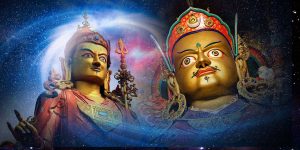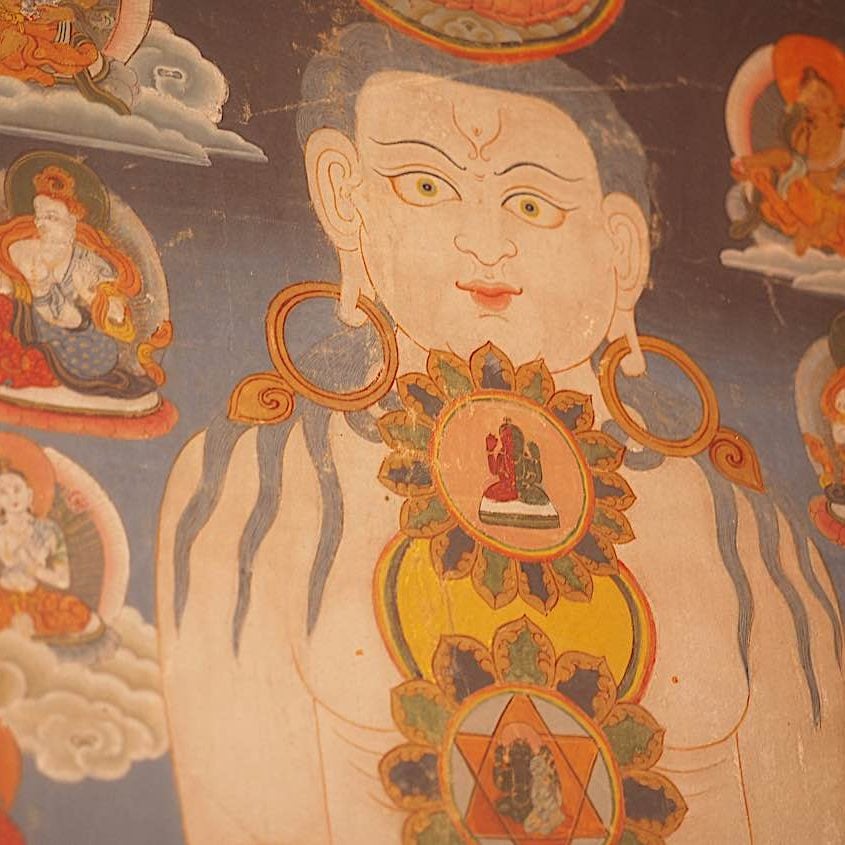What are the ten benefits of Vajrayogini practice? Why is her practice recommended in our busy, terrifying times?
Why do many Buddhist teachers describe Vajrayogini as the one practice for our busy, hectic, terrifying times which can lead us, in one lifetime, to Enlightenment? Why is Vajrayogini the Sarva Buddha Dakini — the Dakini who is the essence of all the Buddhas and Dakinis? What are the ten benefits of her practice? How can we practice Vajrayogini now, if we don’t yet have the empowerment and permission of a teacher? We answer these questions, and more, in this feature on the Bliss Queen, fully Enlightened Vajrayogini.
Special Note: This month (December 24 2022 to January 2023) is Vajrayogini’s special month. For a feature on her special month, see>>
VIDEO Documentary on Vajrayogini, including the 8 Lines of Praise chanted by the Amazing Yoko Dharma:
- Vajrayogini Enlightened wisdom queen, leads us to bliss, clear light and emptiness>>
- Tara the Saviour and Vajrayogini the Sarvabuddhadakini: how are they different, and how are they one?>>
- Heruka and Vajrayogini’s Special Months: Honoring the Blissful Wisdom Mother in the 11th Month>>
- Working with the Magnetizing family of Amitabha, including Vajrayogini>>
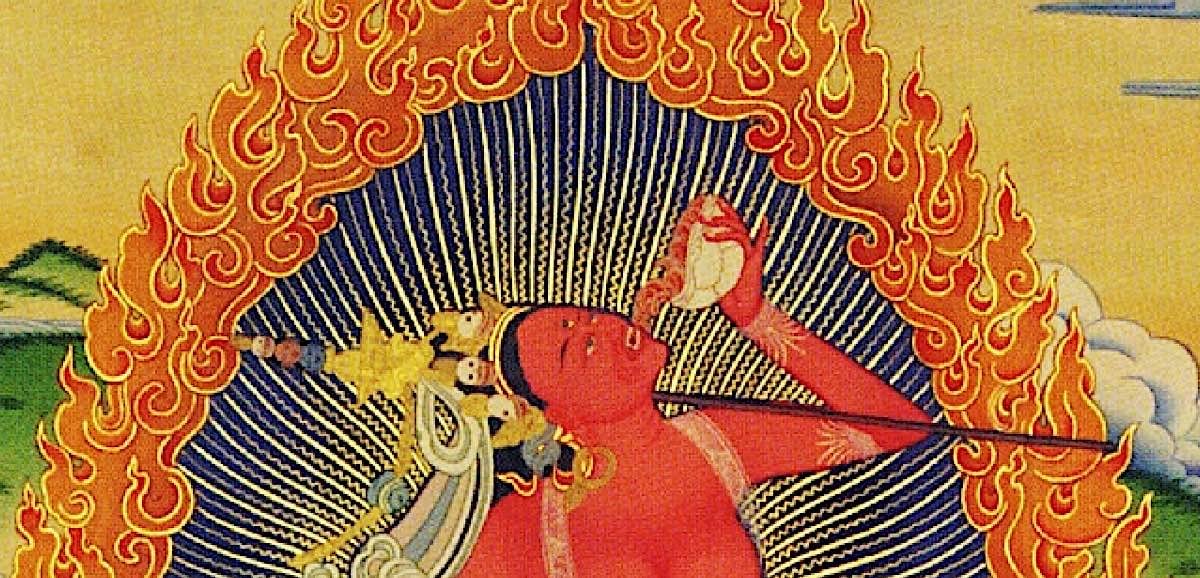
Stories of Vajrayogini’s miracles
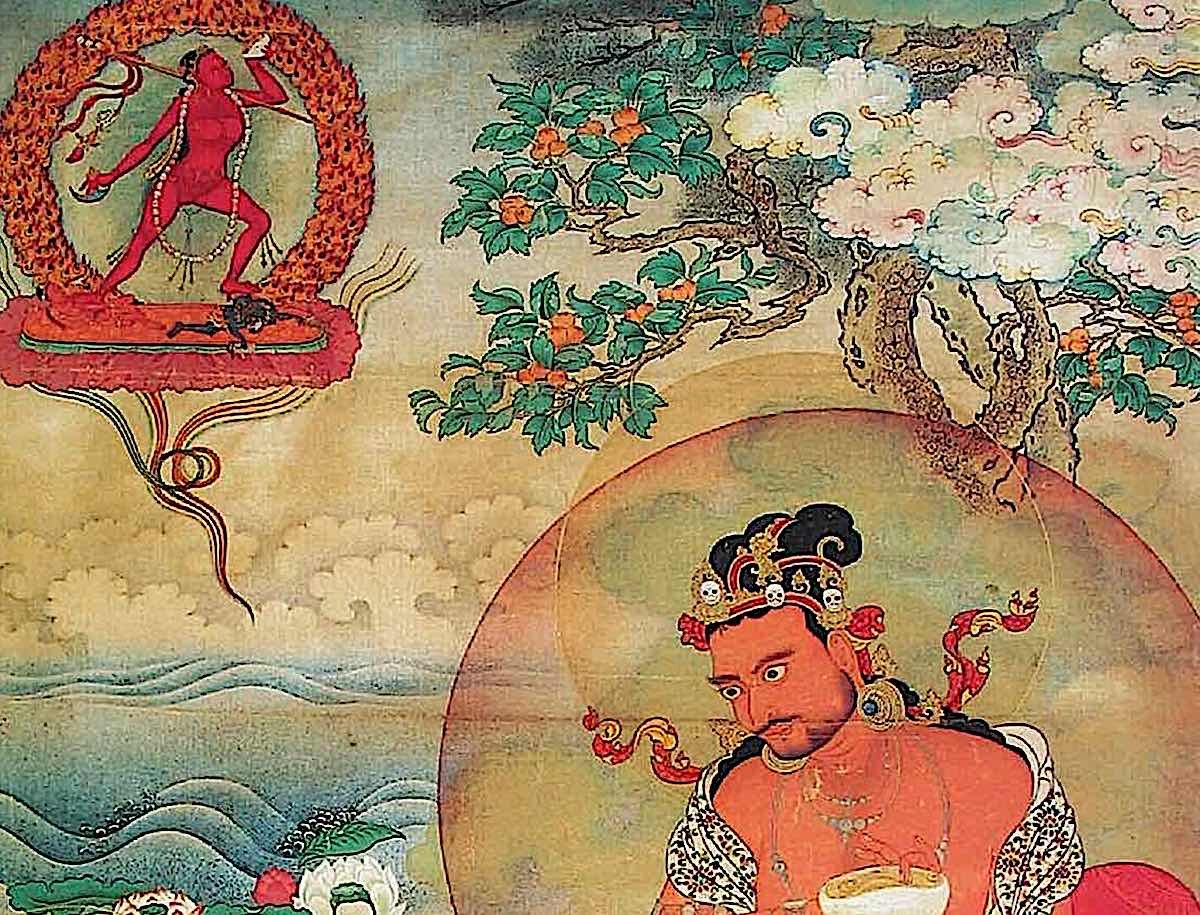
But, Kusali was so moved by her pain, that he bound her on his back with his own garments and started to cross the river. Miraculously, before they reached the halfway mark, the leper transformed into glorious Vajrayogini and he found himself flying up out of the water. Kusali’s guru and the other monks — who practiced Vajrayogini, but had not stirred the compassion for the leper woman — could only stare up in shock.Vajrayogini carried him in that very instant to her Dakini Land, in recognition of his compassion and devout practice.
As the “highest” of the highest yoga practices in Buddhism, the actual practice and mantra of Nacho Kacho Vajrayogini does require the permission from a teacher and empowerment to self-visualize or chant the supreme mantra. You cannot chant the mantra or visualize yourself as the Queen of the Dakinis until you have empowerment and permission — but making offerings and meditating on an image or frontal generation can create merit for future teachings from a qualified teacher.
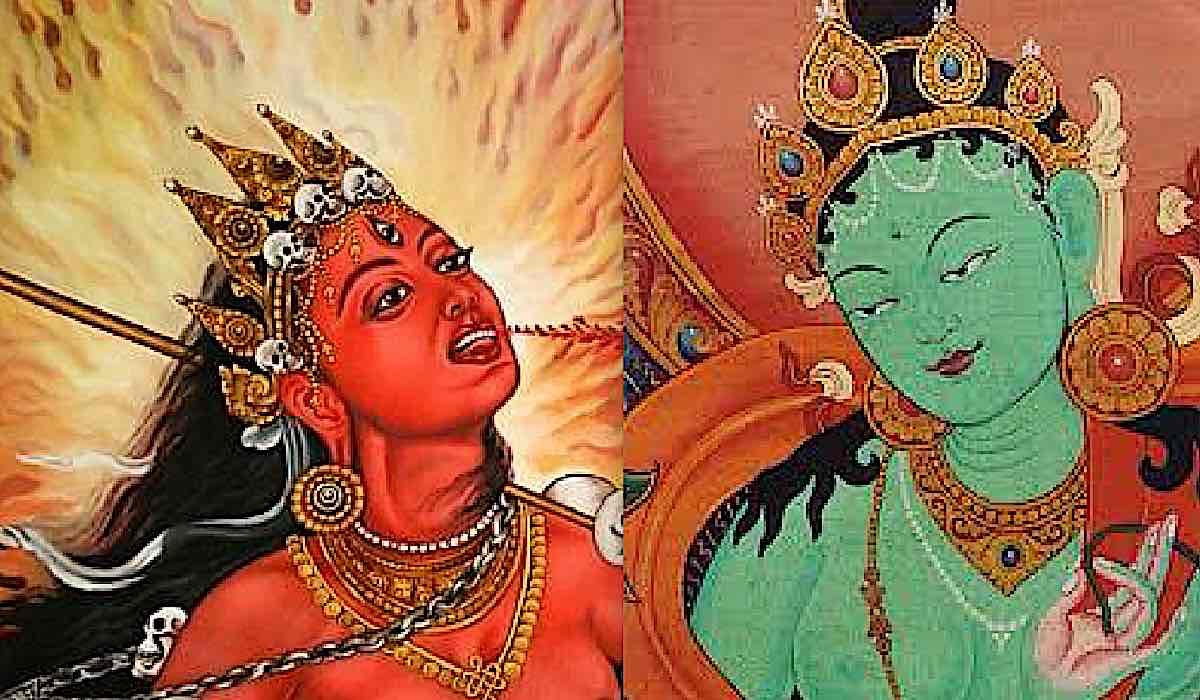
Since Vajrayogini is the Highest Yoga Tantra emanation of Tara, many devout Buddhists practice Tara — which requires no permission — until they have an opportunity for Varayogini practices.
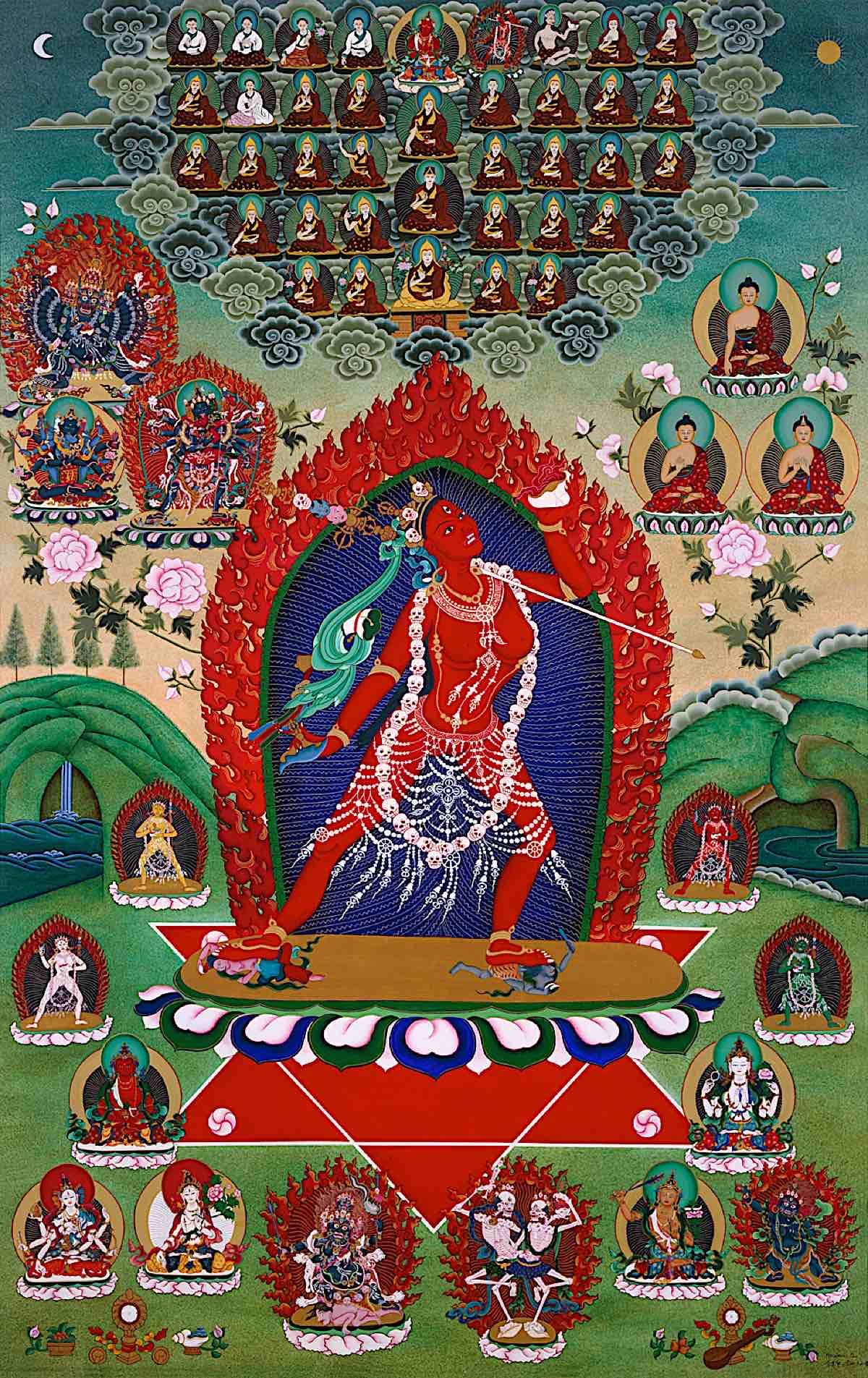
Why is Vajrayogini the Buddha for modern times?
Increasingly, modern life is almost too hectic for deep yogic practices that can lead to Enlightenment in one lifetime. Today, most of us do not have the luxury of retiring to a cave for hermetic practice over many years. Although all Buddhist practices potentially can lead to Enlightenment in one lifetime, Vajrayogini practice — above all others — is the one recommended by teachers for modern times.
Why?
- Clarity and simplicity.
- Brevity — yet acomprehensive practice.
- Easy — yet advanced.
- Her visualization is not difficult even for those who have trouble with visualizations.
- Her practice is complete — containing all the 11 Yogas required to generate the enlightened mind — yet can be accomplished in an astonishingly brief period of time.
- Her practice doesn’t require “retiring from the world” — in fact, it is encouraged to use our “daily lives” as an opportunity to practice. One of the 11 Yogas is the Yoga of Daily Activities. Another is the Yoga of Sleeping. There is even the Yoga of Awakening. And the Yoga of Tasting Nectar — which we can combine with our morning breakfast. In other words, our daily, modern lives become the practice!

The ten benefits of Vajrayogini practice are relevant in modern times
The ten benefits of Vajrayogini practice are also highly appropriate in modern times. Whether you are concerned with the suffering of daily life, the stress of “making a living” or even health issues, Vajrayogini practice is helpful in these practical ways. It is also the ultimate advanced practice — a complete path to Enlightenment exemplified in the 11 Yogas of Vajrayogini. Vajrayogini is also central to Chod practices.

First, to clarify, these benefits are for all sentient beings with a karmic connection to Vajrayogini. It is not a practice only for women, or men. Vajrayogini is a female Dakini — whose essence is Enlightened Wisdom. Yet the main lineages of Vajrayogini were taught by both women and men. Both women and men can attain the ten benefits through the Vajrayogini practice.
It is, however, a practice for the serious practitioner. Not only is a Highest Yoga Tantra, it is a Mother Tantra. The practice may be concise and relatively easy, but it requires commitment, a teacher and a lifetime of practice.
Why is her practice so profound, despite it’s simplicity? Harvard Scholar and author Miranda Shaw, Ph.D. explains:

“She is inarguably the supreme deity of the Tantric pantheon. No male Buddha, including her divine consort, Heruka Cakrasamvara, approaches her in metaphysical or practical import.” [1]
Ten benefits of her practice

The source Tantra — the Condensed Root Tantra of Heruka — explains there are ten key spiritual benefits to practice, many not available from other practices:
- Easy to practice: although a Highest Yoga Tantra practice, the visualizations of the mandala are “relatively” easy, the sadhanas are “relatively” short and the mantra is “relatively” easy. This is all despite the fact that it contains all of the practices and benefits of Chakrasamvara’s practice — without the complex visualizations and practices.
- Ideal for this “degenerate” age: Unlike other practices, Vajrayogini brings fast benefits, since Heruka and Her mandalas are still present in our world. Other deities do not have mandalas in our physical world. By tradition, this means, Her practice is fast. The Dakinis of her mandala are near us at all times.
- Vajrayogini’s mantra is supreme for attainments. Although somewhat long at 32 syllables, it is easy to memorize. It is said that Vajrayogi’s mantra alone is all a practitioner would ever need, provided they have faith, including for the powerful blessings listed in the next benefit. Also, the thirty-two syllables represent the 32 Dakinis of her mandala and their helpful activities.
- Powerful blessings: not just blessings, but quick blessings. And, not just the uncommon Siddhis (accomplishments) such as “realizations” but also the common or mundane blessings of the five powers: pacifying, increasing, empowering, wrathful, and, enlightened activities. In other words, everything from healing, to auspicious merit and good fortune, to accomplishing important mundane activities.
- Can accomplish all attainments: many of the great Mahasiddas accomplished Enlightenment and other realizations from Her practice.
- Can practice both the generation and completion stages together: Unlike most other practices, which require perfection of generation stage practice prior to engaging in completion stage, with Vajrayogini you are shown how to do both together. If you don’t know what this means, teacher guidance is best.
- Overcomes attachments: Vajrayogini’s sensuous nature and red colour signify she is suitable for overcoming desires and cutting attachments (hence, her flaying knife!)
- Contains all other practices: Although a short practice, Vajrayogini’s practice contains the essence of ALL practices.
There are also two relatively more secret (due to complexity) benefits; in other words benefits that aren’t easily understood unless you are already a practitioner and have full instruction. We won’t explain them here, since they are too profound as topics to cover here, but we list them for reference:
- Uncommon Yoga of Inconceivability
- Special body mandala practice
Finally, this is the supreme of the Mother Tantras, which focus on Enlightenment through practices focused on clear light and bliss.
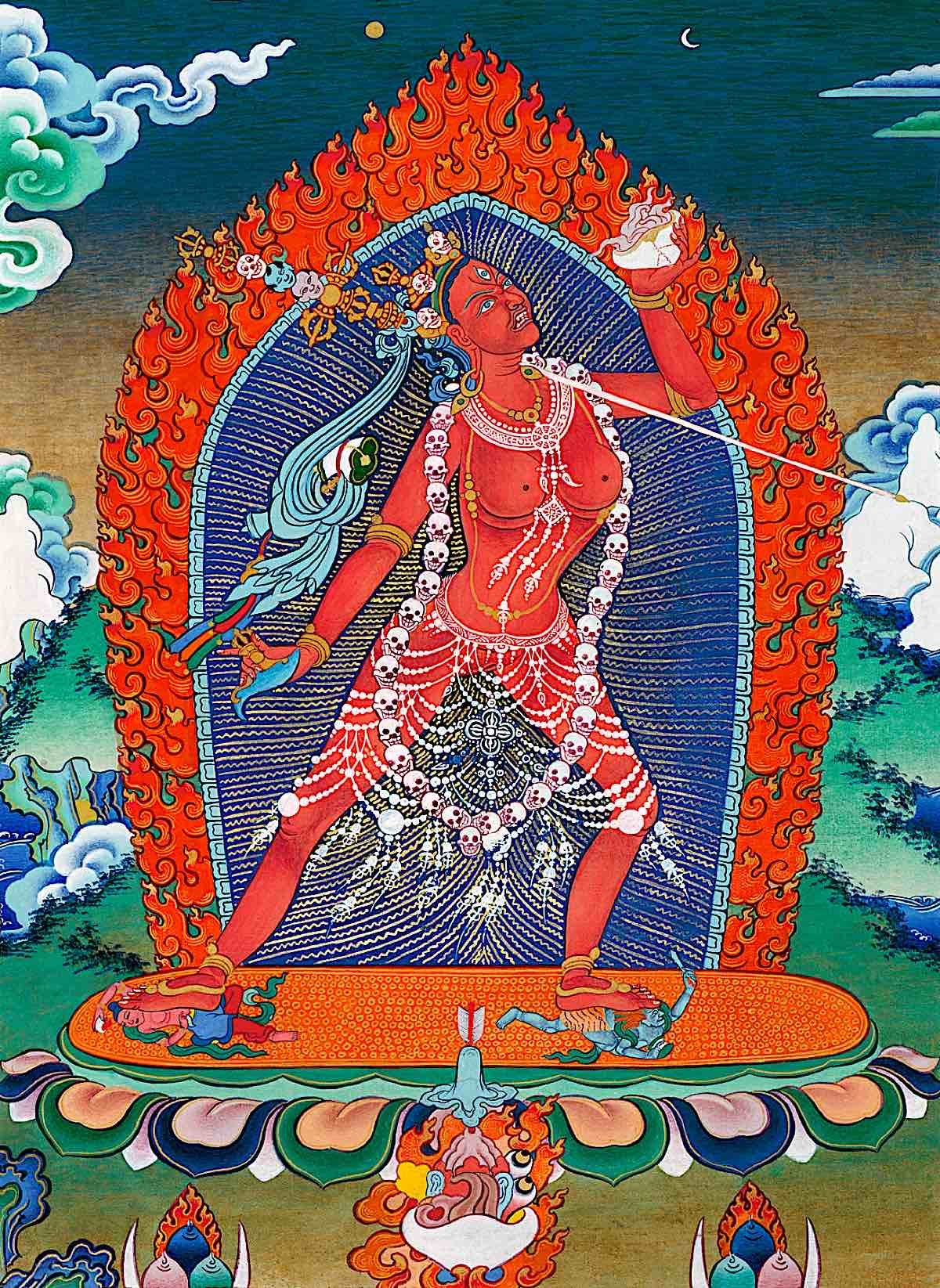
Her symbolism is not for the timid; no, she’s not a vampire
As beautiful as she is, she is naked. She has fangs, like a western movie vampire. What is that all about? She wears skulls and bone ornaments. She has a skullcup in her hand filled with nectar which is blood. She carries a “flaying knife” in her other hand — a traditional curved knife used to “flay” the corpses. She stands on two people — who are actually mundane or worldly gods. Her mandala includes eight “charnal” grounds or cemetaries.
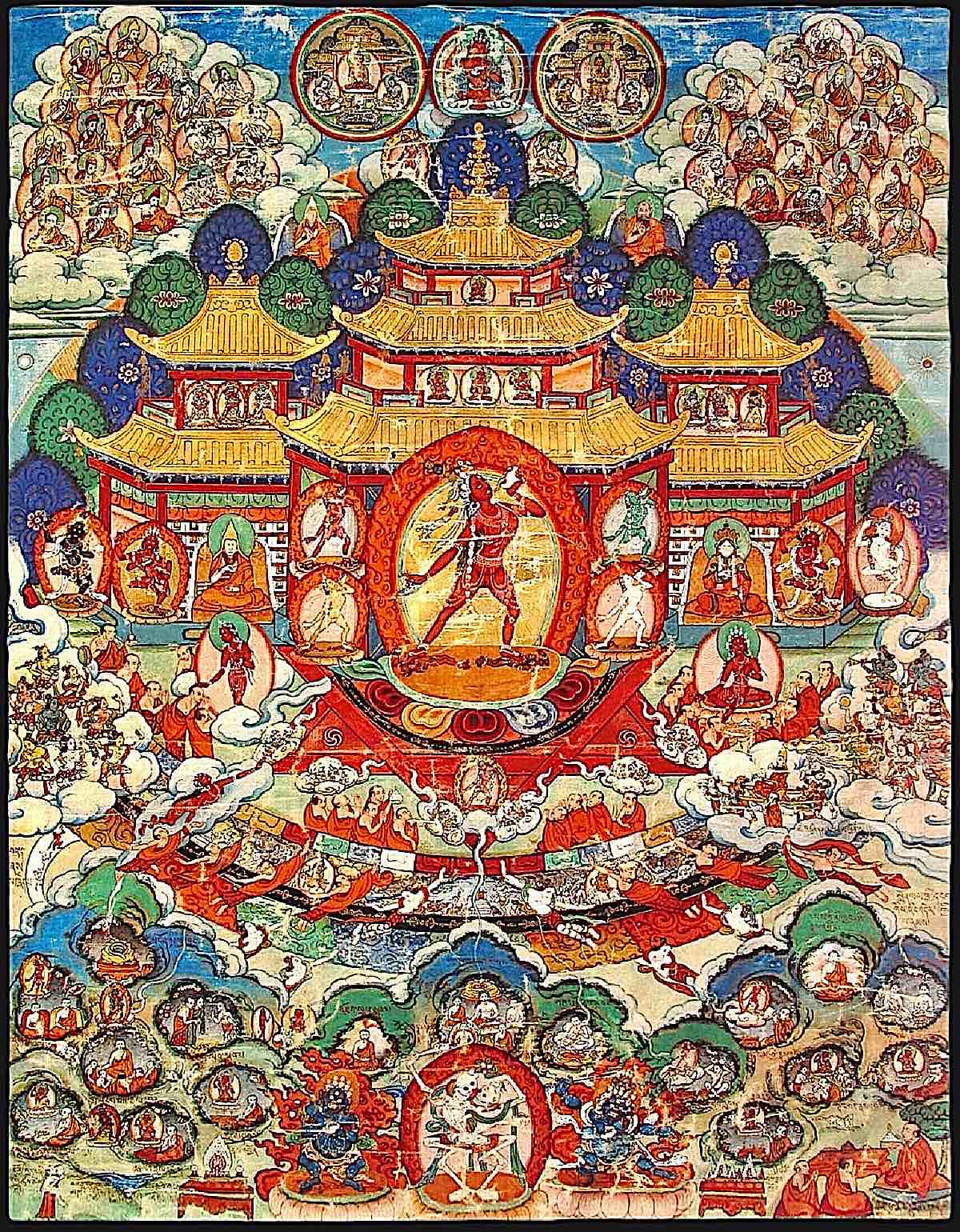
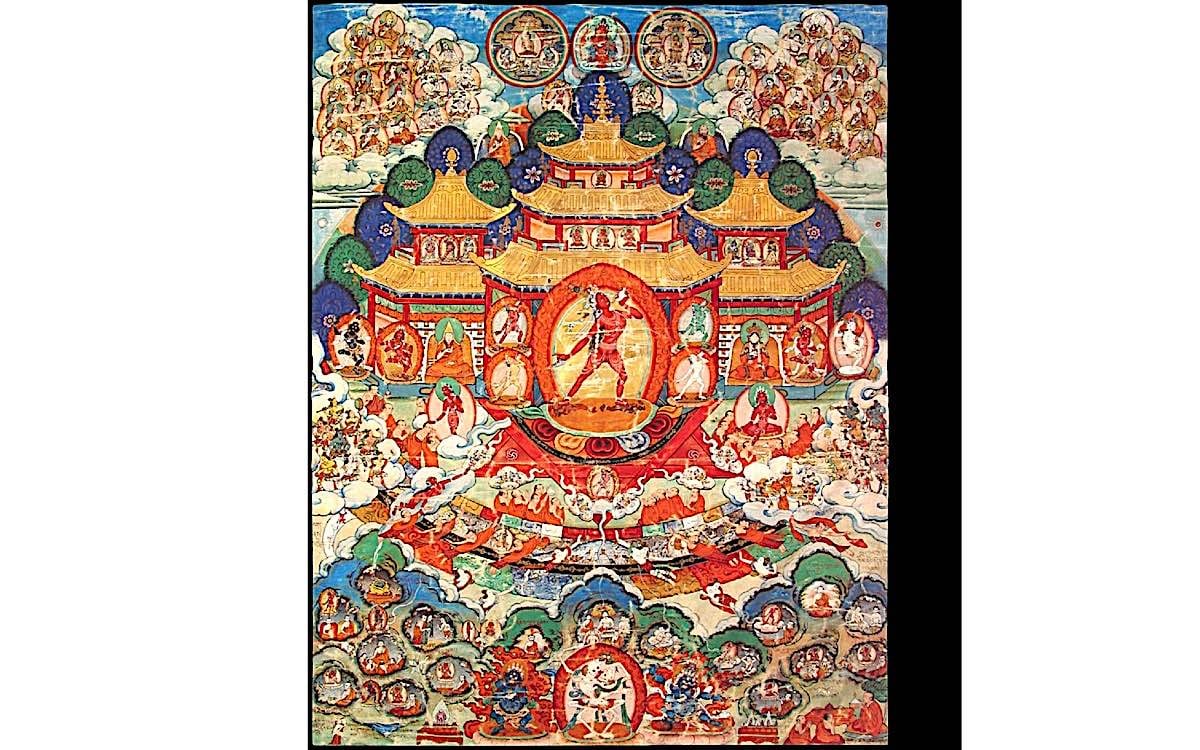
Symbolism step-by-step
- greed (lobha)
- hate (dosa)
- delusion (moha)
- conceit (māna)
- wrong views (micchāditthi)
- doubt (vicikicchā)
- torpor (thīnaṃ)
- restlessness (uddhaccaṃ)
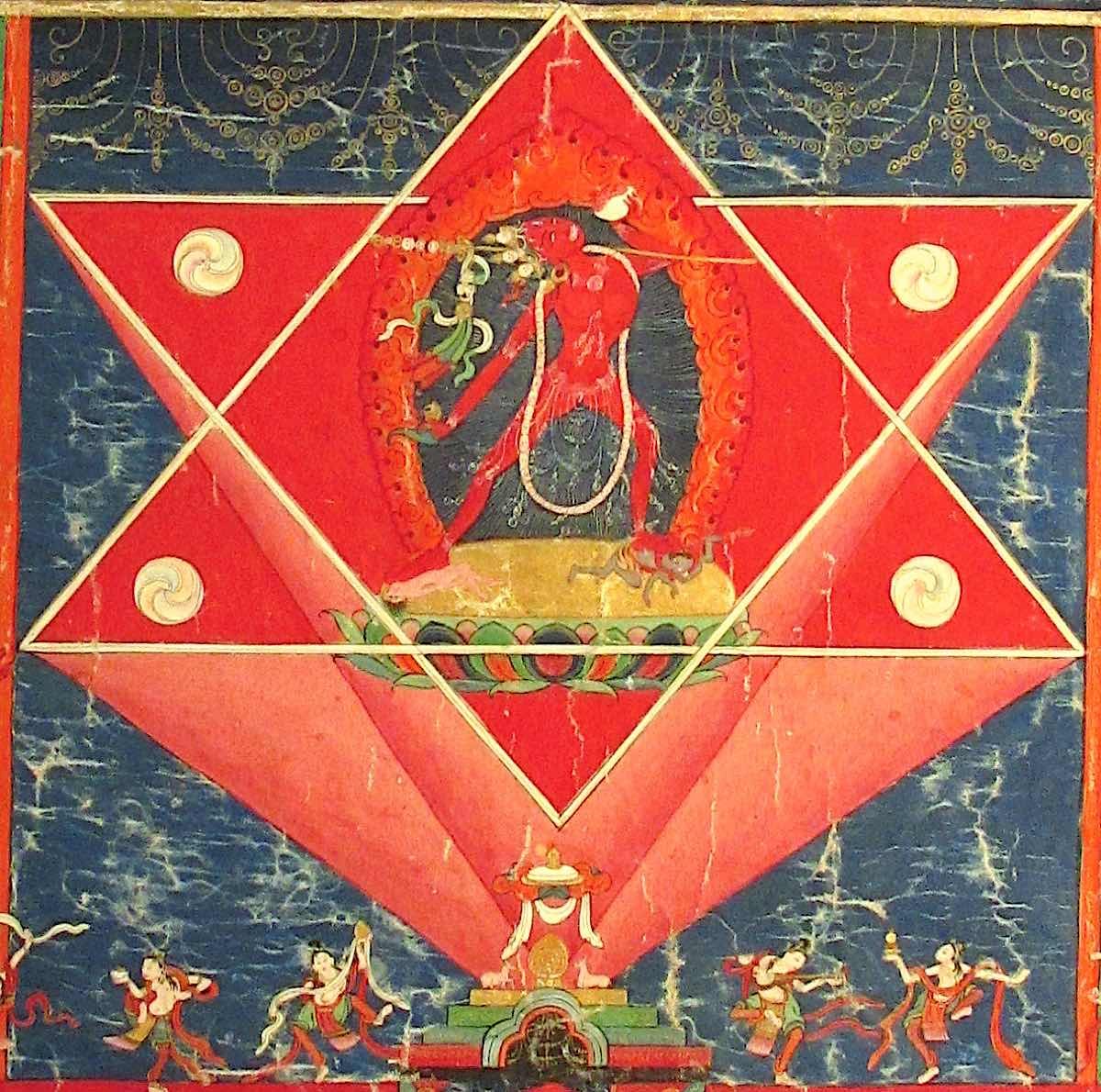
How to practice if you do not yet have empowerment?
“May there be the auspiciousness of swiftly receiving the blessings Of the hosts of glorious, sacred gurus,Vajradhara, Pandit Naropa, and so forth. The glorious lords of all virtue and excellence. May there be the auspiciousness of the Dakini truth body, Perfection of wisdom, the supreme Mother of the Conquerors, the natural clear light, free from elaboration from the beginning, the lady who emanates and gathers all things stable and moving. May there be the auspiciousness of the complete enjoyment body, simultaneously born. A body radiant and beautiful. Ablaze with the glory of the major and minor marks. A speech proclaiming the supreme vehicle with sixty melodies. And a mind of non-conceptual bliss and clarity, possessing the five exalted Wisdoms. May there be the auspiciousness of the emanation body, born from the places, Dakinis who with various form bodies, in various places, fulfill by various means the aims of various ones to be tamed in accordance with their various wishes. May there be the auspiciousness of the supreme Dakini, mantra-born. A venerable lady with a color similar to that of a ruby, with a smiling, wrathful manner, one face, two hands holding a curved knife and skull-cup and two legs in bent and outstretched positions. May there be the auspiciousness of your countless millions of emanations and the hosts of the seventy-two thousand dakinis. Eliminating all the obstructions of practitioners. And bestowing the attainments that are longed for.”

The Eight Lines of Praise to Vajrayogini
OM NAMO BHAGAVATE VAJRA VARAHI BAM HUM HUM PHAT
OM NAMO ARYA APARA-JITE TRAI-LOKYA MATI VIDYESHVARI HUM HUM PHAT
OM NAMO SARVA BHUTA BHAYA VAHE MAHA VAJRA HUM HUM PHAT
OM NAMO VAJRA SANI AJITE APARA-JITE VASHAM KARI-NETRA HUM HUM PHAT
OM NAMO BRAHMANI SHOSHANI ROSHANI KRODHE KARALENE HUM HUM PHAT
OM NAMO TRASANI MARANI PRABHADANI PARAJAYE HUM HUM PHAT
OM NAMO VIJAYE JAMBHANI STAMBHANI MOHANI HUM HUM PHAT
OM NAMO VAJRA VARAHI MAHA YOGINI KAME-SHVARI KHAGE HUM HUM PHAT
OM I bow down to the Bhagavati Vajra Varahi BAM HUM HUM PHAT
OM to the Queen of the female Arya practitioners, invincible in the Three Realms HUM HUM PHAT
OM to you who destroy all fears of harmful spirits with your great Vajra wisdom HUM HUM PHAT
OM to you who remaining on the Vajra-seat cannot be overcome by others, but place them under your power by your glance HUM HUM PHAT
OM to you who as tummo energy-fire in a wrathful body can dessicate Brahma HUM HUM PHAT
OM to you who terrify and dry up the demons and thus can vanquish others HUM HUM PHAT
OM to you who triumph over all that can make you ill-tempered, excited or stupefied HUM HUM PHAT
OM I bow down to Vajravarahi, the Great Yogini who transforms desire HUM HUM PHAT
- Vajrayogini Enlightened wisdom queen, leads us to bliss, clear light and emptiness>>
- Tara the Saviour and Vajrayogini the Sarvabuddhadakini: how are they different, and how are they one?>>
- Heruka and Vajrayogini’s Special Months: Honoring the Blissful Wisdom Mother in the 11th Month>>
- Working with the Magnetizing family of Amitabha, including Vajrayogini>>
NOTES
[1] “Miranda Shaw, Ph.D., Harvard University, is a Buddhist scholar known for her inspiring and groundbreaking work on women in Tantric Buddhism, chronicled in her renowned book Passionate Enlightenment, which has been translated into seven languages. She is also the author of Buddhist Goddesses of India, a thorough and fascinating historic and iconographical study based on extensive research and deep engagement with the divine feminine. Dr. Shaw is currently completing a companion volume, Buddhist Goddesses of Tibet and Nepal, and writing a book on Charya Nritya to be titled Dancing Enlightenment: Tantric Buddhist Dance of Nepal. She serves as Associate Professor of Religious Studies at the University of Richmond and continues to explore and convey her discoveries about the profound sacred arts and embodied spiritual practices of Himalayan Buddhism.” — quoted from Tara Mandala>>
More articles by this author

Guru Rinpoche is ready to answer and grant wishes: “Repeat this prayer continuously” for the granting of wishes
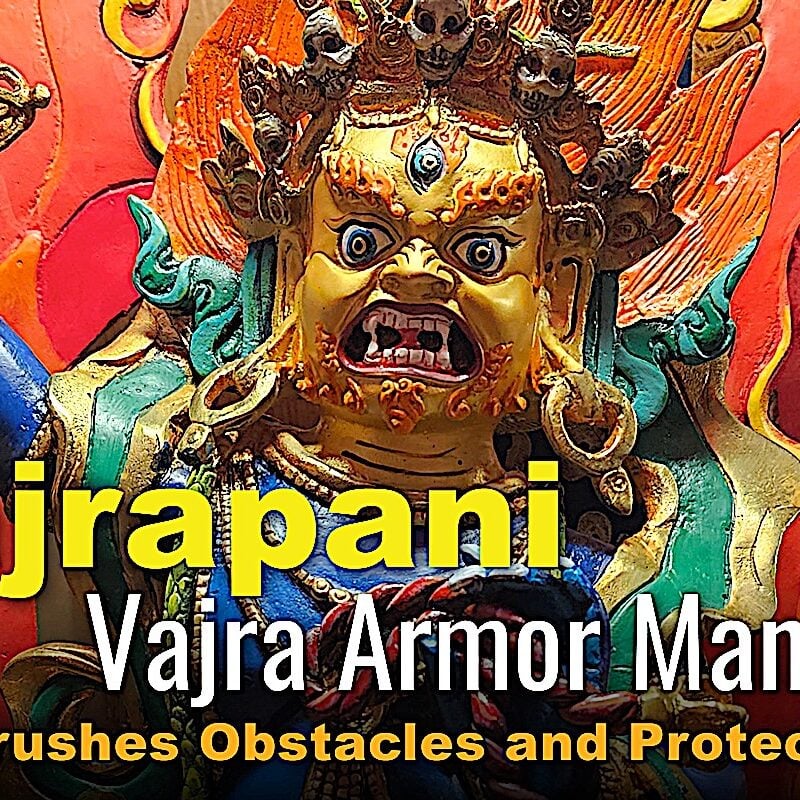
VIDEO: Vajrapani Vajra Armor Mantra: Supreme Protection of Dorje Godrab Vajrakavaca from Padmasambhava
Search
Latest Features
Please support the "Spread the Dharma" mission as one of our heroic Dharma Supporting Members, or with a one-time donation.
Please Help Support the “Spread the Dharma” Mission!

Be a part of the noble mission as a supporting member or a patron, or a volunteer contributor of content.
The power of Dharma to help sentient beings, in part, lies in ensuring access to Buddha’s precious Dharma — the mission of Buddha Weekly. We can’t do it without you!
A non-profit association since 2007, Buddha Weekly published many feature articles, videos, and, podcasts. Please consider supporting the mission to preserve and “Spread the Dharma." Your support as either a patron or a supporting member helps defray the high costs of producing quality Dharma content. Thank you! Learn more here, or become one of our super karma heroes on Patreon.
Lee Kane
Author | Buddha Weekly
Lee Kane is the editor of Buddha Weekly, since 2007. His main focuses as a writer are mindfulness techniques, meditation, Dharma and Sutra commentaries, Buddhist practices, international perspectives and traditions, Vajrayana, Mahayana, Zen. He also covers various events.
Lee also contributes as a writer to various other online magazines and blogs.






